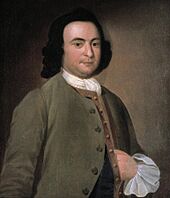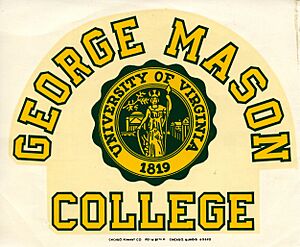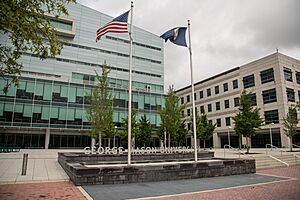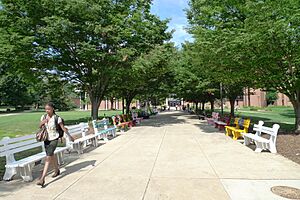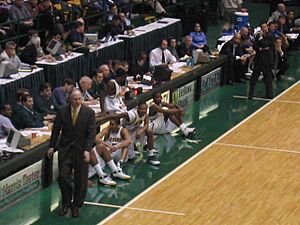George Mason University facts for kids
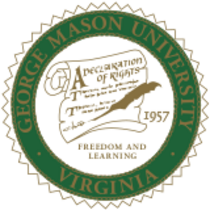 |
|
|
Former names
|
Northern Virginia University Center of the University of Virginia (1949–1956) University College of the University of Virginia (1956–1959) George Mason College of the University of Virginia (1959–1972) |
|---|---|
| Motto | "Freedom and Learning" |
| Type | Public research university |
| Established | 1949 |
| Founder | Virginia General Assembly |
| Accreditation | SACS |
|
Academic affiliations
|
|
| Endowment | $222.2 million (2024) |
| President | Gregory Washington |
| Provost | James Soto Antony |
| Rector | Charles "Cully" Stimson |
|
Academic staff
|
2,133 (fall 2023) |
| Students | 39,763 (fall 2024) |
| Undergraduates | 27,160 (fall 2023) |
| Postgraduates | 11,804 (fall 2023) |
| Location |
,
Virginia
,
US
38°49′52″N 77°18′29″W / 38.831°N 77.308°W |
| Campus | Large Suburb, 953 acres (386 ha) (Fairfax / George Mason, Virginia), 1,148 acres (465 ha) total |
| Location of Campuses |
|
| Media | Fourth Estate (newspaper) WGMU Radio (radio station) |
| Colors | Green Gold |
| Nickname | Patriots |
|
Sporting affiliations
|
|
| Mascot | The Patriot |
 |
|
George Mason University (often called GMU or just Mason) is a large public university in Fairfax County, Virginia, United States. It's located close to Washington, D.C.. The university is named after George Mason, who was one of the Founding Fathers of the United States.
Mason started in 1949 as a small branch of the University of Virginia. It became its own independent university in 1972. Since then, it has grown to be the largest public university in Virginia based on how many students attend. It offers a mix of modern job-focused education and traditional liberal arts studies.
The university has four campuses in the United States and one international campus in Incheon, South Korea. The main campus is in the Fairfax, Virginia area. Mason is known for its strong research programs. Two of its economics professors have even won the Nobel Memorial Prize in Economics.
| Top - 0-9 A B C D E F G H I J K L M N O P Q R S T U V W X Y Z |
History of George Mason University
How Mason Started in the 20th Century
In 1949, the University of Virginia opened a small center in Northern Virginia. This center was for working adults and other students who wanted to take classes in the evenings. They offered various courses, like "Government in the Far East" and "English Composition." By 1952, over 1,000 students were taking classes.
In 1956, the Virginia government changed this center into University College, a branch of the University of Virginia. In 1958, it was renamed George Mason College.
The City of Fairfax gave 150 acres of land to the University of Virginia for a new campus. This land is now the main Fairfax Campus. Construction began in 1962, and in 1964, the new campus welcomed 356 students.
In 1966, George Mason College became a four-year school that could grant degrees. Local areas like Fairfax County and Arlington County helped buy more land, making the Fairfax Campus 600 acres. The goal was for it to become a major regional university.
In 1972, George Mason College officially separated from the University of Virginia and became George Mason University.
George W. Johnson became the fourth president in 1978. During his 18 years, the university grew a lot. It added a law school and a new campus in Arlington. Mason also started offering doctoral degrees. Later, a third campus was planned in Prince William County, Virginia. Many important buildings, like the Student Union Building II and EagleBank Arena, were built during his time. The number of students more than doubled to over 24,000 by 1996.
In 1996, Alan Merten became president. He believed the university should connect with its local, national, and global communities. During his time, Mason hosted a big technology conference and celebrated another Nobel Prize-winning professor. The men's basketball team even made it to the Final Four in 2006! Student numbers grew to about 33,000 by 2012, making Mason Virginia's largest public university.
Mason in the 21st Century
Ángel Cabrera became the sixth president in 2012. He worked to create a new plan for Mason's future.
In 2013, Mason decided to join the Atlantic 10 Conference (A-10) for sports, leaving the Colonial Athletic Association. Mason started competing in the A-10 in the 2013–2014 school year.
In 2018, some information came out about how certain donors had a say in who the university hired for teaching jobs in its law and economics schools. Mason's president said this raised questions about fairness and promised to change the rules so donors couldn't be on hiring committees anymore.
Cabrera left in 2019, and Anne B. Holton served as a temporary president.
On July 1, 2020, Gregory Washington became the university's eighth president. He is the first African-American president of George Mason University.
During the COVID-19 pandemic, Mason switched to online classes in March 2020. For a while, they offered a mix of online and in-person classes.
University Campuses
George Mason University has four campuses in Virginia, USA. Three are in the Northern Virginia area near Washington, D.C., and one is in Virginia's Blue Ridge Mountains. Mason also has an international campus in Incheon, South Korea. The Blue Ridge campus works with the Smithsonian Institution.
Fairfax Campus: The Main Hub
The main Fairfax Campus is about 677 acres in central Fairfax County. It's just south of the City of Fairfax and about 20 miles from Washington, D.C..
Important buildings include the Johnson Center, a large student union building. The Center for the Arts is a big concert hall. There's also the Long and Kimmy Nguyen Engineering Building, Exploratory Hall for science, and an astronomy observatory. The campus has three gyms and a swimming center for students. Sports stadiums for track, baseball, soccer, and more are also here.
George Mason Statue and Memorial
A bronze statue of George Mason stands on campus. It was put there in 1996. The statue shows George Mason holding his first draft of the Virginia Declaration of Rights. This document later helped create the U.S. Constitution's Bill of Rights.
In 2021, a memorial for the enslaved people of George Mason was added near the statue. It tells the stories of people like Penny and James, who were enslaved at Mason's home, Gunston Hall.
Arlington Campus: Mason Square
The Arlington Campus, called Mason Square since 2022, is 5.2 acres in Virginia Square. It's an urban area about 4 miles from downtown Washington, D.C. This campus started in 1979 when the university got a law school. It houses the Antonin Scalia Law School and the Schar School of Policy and Government. It also has the Jimmy and Rosalynn Carter School for Peace and Conflict Resolution. A new building, Fuse at Mason Square, is expected to be finished in 2025.
Getting Around Arlington Campus

Students can get to the Arlington campus using the Washington Metro subway at the Virginia Square–GMU station. There are also campus shuttles and public buses.
Science and Technology Campus
This campus opened in 1997 in Manassas, Virginia, on 134 acres. Over 4,000 students take classes here in subjects like bioinformatics, biotechnology, and information technology. There are also programs in health and recreation. A lot of research happens in the Biomedical Research Laboratory. The Hylton Performing Arts Center, with two large halls, opened in 2010.
The Freedom Aquatic and Fitness Center is also on this campus. The SMART Lab (Sports Medicine Assessment Research and Testing lab) is known for its research on concussions. In 2015, the campus was renamed the Science and Technology Campus.
Smithsonian-Mason School of Conservation
This campus in Front Royal, Virginia, is a partnership with the Smithsonian Institution. It opened in 2012 and focuses on training students in global conservation. It has teaching labs, classrooms, and offices. Students live on campus and can see Shenandoah National Park from the dining hall.
Mason Korea: An International Campus
|
Mason Korea
Korea Campus
|
|
|---|---|
| Songdo Campus Korean: 송도 캠퍼스 |
|
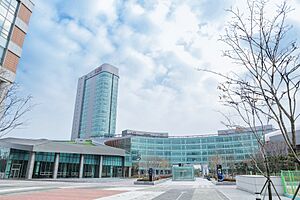
Data Center, Library, Guest House, Student's Hall
|
|
| Country | |
| Region | Seoul Capital Area (Sudogwon) |
| Metropolitan City | |
| District | Yeonsu-gu |
| International Business District | Songdo |
| Postal Code |
21985
|
Mason Korea opened in March 2014 in the Songdo International Business District in South Korea. This area is designed for many people and is about 25 miles from Seoul. It's also a short flight from China and Japan.
Students at Mason Korea earn the same diploma as students at the main campus in Virginia. All classes are taught in English.
Academics and Learning at Mason
| ARWU World | 201–300 |
|---|---|
| THES World | 401–500 |
| USNWR National University | 109 |
| Washington Monthly National University | 61 |
| Forbes | 91 |
Mason offers many types of degrees, from bachelor's to doctoral degrees. The university focuses on combining hands-on, job-focused education with a broad liberal arts curriculum. There are 17 students for every teacher. Most undergraduate classes have fewer than 30 students.
University Rankings
In 2024, U.S. News & World Report ranked George Mason among the top 110 National Universities. It was also ranked #52 among Top Public Schools. Mason was recognized for its engineering programs, nursing, and economics. It was also listed as a "Top Performer on Social Mobility," meaning it helps students from all backgrounds succeed.
Mason Traditions
Students at Mason often decorate the statue of George Mason on the Fairfax campus. Some even rub the statue's toe for good luck! Many students take graduation photos with the statue. The university also has a "George Mason Fight Song."
Every spring, student groups compete to paint one of the 38 benches on the Quad in front of Fenwick Library. This is a fun way for groups to show off their creativity and get noticed.
Student Housing
George Mason University has about 40 dorms on the Fairfax campus. About 22 of these are just for first-year students. Many dorms are named after famous places in Virginia.
Dorms for First-Year Students
- Commonwealth Hall and Dominion Hall: These are suite-style dorms, meaning students have their own rooms but share a living area and bathroom with a few others.
- Presidents Park: This is a group of twelve traditional-style dorms. Each dorm has rooms along a hallway, sharing a common bathroom.
- Taylor Hall: Another traditional-style dorm.
- The Commons: A group of seven traditional-style dorms.
Dorms for Upper-Class Students
- Eastern Shore, Blue Ridge, Sandbridge, Piedmont, Tidewater, and Whitetop: These are suite-style dorms.
- Hampton Roads Hall, Angel Cabrera Global Center, Liberty Square, Rogers Hall, Northern Neck, and Potomac Heights: These are apartment-style dorms, which means students have their own bedrooms and share a kitchen and living room.
- The Townhouses: These are apartments located very close to the Fairfax campus.
Dorms for Graduate Students
- Beacon Hall: An apartment-style dorm for graduate students.
Student Groups and Media
Mason has over 500 student groups! These groups cover many interests, like academics, sports, religion, and careers.
The university also has student-run media:
- Fourth Estate: This is the student newspaper, available online and weekly.
- Phoebe: A journal that publishes student writing and art.
- WGMU Radio: The student radio station, playing music, talk shows, sports, and news. It's also where you can hear George Mason's basketball games.
Greek Life
Mason has 42 fraternities and sororities, with about 1,800 students involved. These groups don't have their own houses on campus, but they hold events, charity activities, and recruitment on the Fairfax Campus.
Sports and Athletics
Division I Sports Teams
The George Mason Patriots are the university's sports teams. They compete in Division I of the National Collegiate Athletic Association (NCAA). Most sports teams are part of the Atlantic 10 Conference. About 485 student-athletes play in 22 men's and women's sports. These include baseball, basketball, soccer, swimming, tennis, volleyball, and wrestling.
Club Sports
Besides the NCAA teams, George Mason University also has many club sports for students who want to play competitively but not at the Division I level.
Performing Arts
The Mason Players is a student group led by faculty that puts on six theater productions each year.
University's Influence and Ideas
George Mason University is known for helping students from different backgrounds succeed. It's ranked highly for "Social Mobility," meaning it helps students improve their economic situation after graduation. The university is also recognized for supporting freedom of speech.
Mason is home to two very different schools: the Antonin Scalia Law School and the Jimmy and Rosalynn Carter School for Peace and Conflict Resolution. The law school is named after a conservative U.S. Supreme Court Justice, while the Carter School is named after a liberal U.S. President and First Lady. This shows that the university tries to have a balance of different ideas.
Economics Department and Funding
George Mason University's Department of Economics has received donations from the Charles Koch Foundation. There was some discussion about whether these donations gave the donors too much influence over the department's ideas. George Mason University has since changed its rules to make sure donors don't have a say in hiring decisions.
Law School and its Connections
The Antonin Scalia Law School is named after a conservative Supreme Court Justice. Some Supreme Court Justices have also taught there. The law school has strong ties with the Federalist Society, a group that focuses on conservative legal ideas. This has led to discussions about the law school's influence on the U.S. legal system.
Public Policy School and Former Officials
George Mason University's public policy school, the Schar School of Policy and Government, has hired former U.S. intelligence officials. For example, General Michael Hayden, who used to lead the Central Intelligence Agency (CIA), taught there. This has led to discussions about the school's connections to government and intelligence.
Notable People from George Mason University
Faculty Members
- Notable George Mason University faculty include:
-
Brett Kavanaugh, U.S. Supreme Court Justice
-
Neil Gorsuch, U.S. Supreme Court justice
-
Clarence Thomas, U.S. Supreme Court justice
-
Vernon L. Smith, Nobel Prize winning economist
-
James M. Buchanan, Nobel Prize winning economist
-
Vasily Aksyonov, Russian novelist and poet
-
Walter E. Williams, economist and author
-
Francis Fukuyama, political scientist and economist
-
Michael Hayden, former Director of the Central Intelligence Agency (CIA)
-
Andrew McCabe, former acting director of the Federal Bureau of Investigation (FBI)
Alumni (Graduates)
- Notable George Mason University Alumni Include:
-
Anna Escobedo Cabral, former Treasurer of the United States
-
Karl Rove, Senior Advisor to President George W. Bush
-
Justin Bour, American professional baseball player
-
Ken Cuccinelli, former Attorney General of Virginia
-
Kathleen L. Casey, Commissioner of the U.S. Securities and Exchange Commission
-
Denise Turner Roth, former Administrator of General Services Administration
-
Abdiweli Gaas, former Prime Minister of Somalia
-
Mohammad Khazaee, former Representative of Iran to the United Nations
See also
 In Spanish: Universidad George Mason para niños
In Spanish: Universidad George Mason para niños
- Northern Virginia Community College


